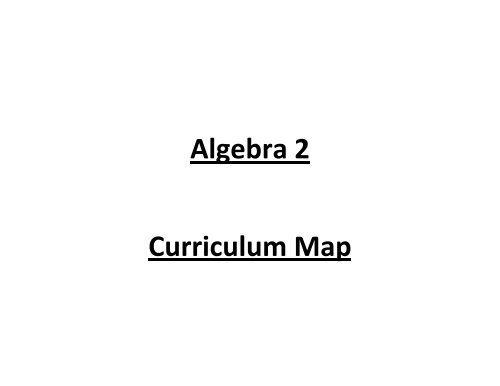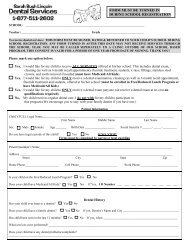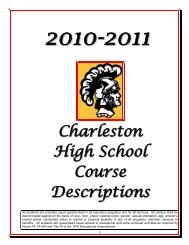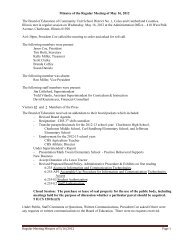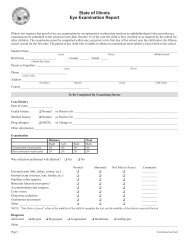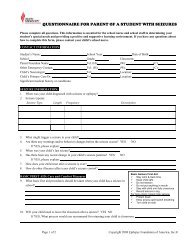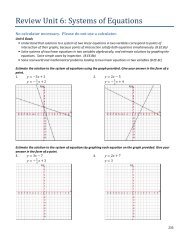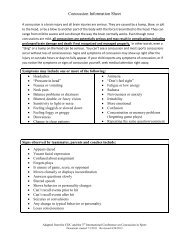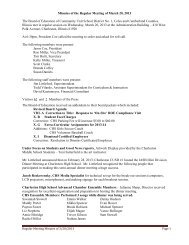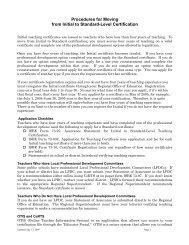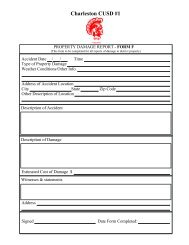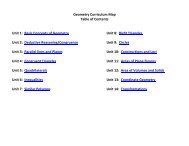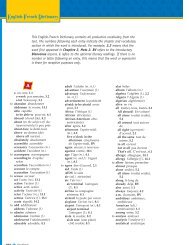Algebra 2 Curriculum Map
Algebra 2 Curriculum Map
Algebra 2 Curriculum Map
Create successful ePaper yourself
Turn your PDF publications into a flip-book with our unique Google optimized e-Paper software.
<strong>Algebra</strong> 2<br />
<strong>Curriculum</strong> <strong>Map</strong>
Table of Contents<br />
Unit 1: Basic Concepts of <strong>Algebra</strong> Unit 7: Solving Quadratic Equations<br />
Unit 2: Inequalities Unit 8: Variation and Proportion<br />
Unit 3: Linear Equations and Functions Unit 9: Analytic Geometry<br />
Unit 4: Polynomials Unit 10: Exponential and Logarithmic Functions<br />
Unit 5: Rational Expressions Unit 11: Sequences and Series<br />
Unit 6: Radical Functions Unit 12: Matrices and Determinants
Purpose of a <strong>Curriculum</strong> <strong>Map</strong><br />
The purpose of a curriculum map is to document the intended<br />
relationship between components of the curriculum. Used as an analysis<br />
tool, a curriculum map allows instructors to review the curriculum to check<br />
for unnecessary redundancies, inconsistencies, misalignments, weaknesses<br />
and gaps. Ultimately, a curriculum map will be the bridge between the state<br />
standards and state-mandated curriculum and the taught and learned<br />
curriculum.
Unit 1: Basic Concepts of <strong>Algebra</strong><br />
Approximate Duration of Study: 2 weeks When to Study: Aug/Sept<br />
CCS Essential Question Concept Skills Assessments Helpful Strategies and Resources<br />
A.SSE.1.a<br />
A.SSE.1.b<br />
A.CED.1<br />
A.REI.1<br />
A.REI.3<br />
Why are “the order<br />
of operations” and<br />
other properties of<br />
mathematics<br />
important?<br />
Why is advantageous<br />
to use and solve<br />
equations<br />
algebraically for realworld<br />
problems?<br />
Variables and<br />
Expressions<br />
Order of<br />
Operations<br />
Distributive<br />
Property<br />
Write verbal<br />
expressions for<br />
algebraic<br />
expressions<br />
Write algebraic<br />
expressions for<br />
verbal<br />
expressions<br />
Evaluate<br />
numerical and<br />
algebraic<br />
expressions by<br />
using the order<br />
of operations<br />
Use the<br />
Distributive<br />
Property to<br />
simplify and<br />
evaluate<br />
expressions<br />
Equations Solve equations<br />
with two<br />
variables given<br />
Writing<br />
Equations<br />
One-step<br />
equations<br />
a domain<br />
Translate<br />
sentences into<br />
equations<br />
Solve equations<br />
by using<br />
addition or<br />
subtraction<br />
McDougal Littell/ Houghton Mifflin – “<strong>Algebra</strong>:<br />
Stucture and Method Book2” – Chapter 1 and<br />
accompanying resources<br />
<strong>Algebra</strong>ic and Numeric Expressions (pdf)<br />
Evaluating Expressions(pdf)<br />
Simplifying <strong>Algebra</strong>ic Expressions (pdf)
A.REI.1<br />
A.REI.3<br />
A.REI.1<br />
A.REI.3<br />
A.REI.1 When would we<br />
want to use the<br />
absolute value of<br />
numbers?<br />
A.CED.4 What are some<br />
careers that utilize<br />
literal equations on a<br />
very regular basis?<br />
Multi-Step<br />
Equations<br />
Equations<br />
with the<br />
variable on<br />
each side<br />
Absolute<br />
Value<br />
Equations<br />
Literal<br />
Equations<br />
Solve equations<br />
by using<br />
multiplication<br />
or division<br />
Solve equations<br />
involving more<br />
than one<br />
operation<br />
Solve equations<br />
with the<br />
variable on<br />
each side<br />
Solve equations<br />
involving<br />
grouping<br />
symbols<br />
Evaluate<br />
absolute value<br />
expressions<br />
Solve absolute<br />
value equations<br />
Solve equations<br />
for given<br />
variables<br />
Chapter 1 Test<br />
o Ch. 1 Test Page 2<br />
Vocabulary: Domain, Absolute Value, Inequality, Opposite, Additive Inverse, Multiplicative Inverse, Root, Constant, Identity, Empty Set
Unit 2: Inequalities<br />
Approximate Duration of Study: 2 weeks When to Study: Sept<br />
CCS Essential Question Concept Skills Assessments Helpful Strategies and Resources<br />
A.REI.3 -How are inequalities<br />
and equations alike?<br />
How are they<br />
different?<br />
How do the words<br />
“and” and “or” affect<br />
the outcome of an<br />
inequality?<br />
Inequalities<br />
Involving<br />
Addition and<br />
Subtraction<br />
Inequalities<br />
Involving<br />
Multiplication<br />
and Division<br />
Solving Multi-<br />
Step<br />
Inequalities<br />
Solving<br />
Compound<br />
Inequalities<br />
Inequalities<br />
involving<br />
Absolute<br />
Value<br />
A.REI.12 Inequalities in<br />
Two Variables<br />
Solving linear<br />
inequalities by using<br />
addition and<br />
subtraction<br />
Solving linear<br />
inequalities by using<br />
multiplication and<br />
division<br />
Solve linear<br />
inequalities<br />
involving more than<br />
one operation<br />
Solve inequalities<br />
involving the<br />
Distributive<br />
Property<br />
Solve compound<br />
inequalities<br />
containing the word<br />
“and” and graph<br />
their solution set<br />
Solve compound<br />
inequalities<br />
containing the word<br />
“or” and graph their<br />
solution set<br />
Solve and graph<br />
absolute value<br />
inequalities (both <<br />
and >)<br />
Graph linear<br />
inequalities on the<br />
coordinate plane<br />
Chapter 2 Test<br />
o Ch 2 Test Page 2<br />
Solve inequalities by<br />
graphing<br />
Vocabulary: Inequality, Compound Inequality, Linear Inequality, Conjunction, Disjunction<br />
McDougal Littell/ Houghton Mifflin – “<strong>Algebra</strong>:<br />
Stucture and Method Book2” – Chapter 2 and<br />
accompanying resources<br />
Absolute Value Inequalities(pdf)<br />
Compound Inequalities(pdf)<br />
Distance Rate Time Word Problems(pdf)<br />
Mixture Word Problems(pdf)<br />
Solving Absolute Value Equations(pdf)<br />
Solving Inequalities(pdf)<br />
Solving Multi-Step Equations(pdf)<br />
Work Word Problems(pdf)
Unit 3: Linear Equations and Functions<br />
Approximate Duration of Study: 3 – 4 weeks When to Study: Sept/Oct<br />
CCS Essential Question Concept Skills Assessments Helpful Strategies and Resources<br />
A.REI.10 Graphing Identify linear equations,<br />
McDougal Littell/ Houghton Mifflin – “<strong>Algebra</strong>:<br />
Linear<br />
intercepts, and zeros<br />
Stucture and Method Book2” – Chapter 3 and<br />
Equations Graph linear equations<br />
accompanying resources<br />
A.REI.10 Solving linear Solve equations by<br />
equations by<br />
graphing<br />
graphing and identifying<br />
the root<br />
Estimate solutions to an<br />
equation by graphing<br />
Graphing Absolute Value Equations(pdf)<br />
Graphing Linear Inequalities(pdf)<br />
Review Linear Equations(pdf)<br />
Rate of Change<br />
and Slope<br />
Direct<br />
Variation<br />
A.REI.10 Graphing<br />
Equations in<br />
Slope-Intercept<br />
Form<br />
A.CED.2 Writing<br />
equations in<br />
slope-intercept<br />
form<br />
Equations in<br />
different forms<br />
Use rate of change to<br />
solve problems<br />
Find the slope of a line<br />
Write and graph direct<br />
variation equations<br />
Solve problems involving<br />
direct variation<br />
Write and graph linear<br />
equations in slopeintercept<br />
form<br />
Model real-world data<br />
with equations in slopeintercept<br />
form<br />
Write an equation of a<br />
line in slope-intercept<br />
form given the slope and<br />
one point<br />
Write an equation of a<br />
line in slope-intercept<br />
form given two points<br />
Write equations of lines<br />
in standard form<br />
Write equations of lines<br />
in point-slope form
A.CED.2<br />
A.REI.10<br />
A.REI.6<br />
A.REI.11<br />
A.REI.5<br />
A.REI.6<br />
A.REI.5<br />
A.REI.6<br />
How might one<br />
determine the<br />
most efficient<br />
method for solving<br />
a system of<br />
equations?<br />
Parallel and<br />
Perpendicular<br />
Lines<br />
Write linear equations in<br />
different forms<br />
Write equations of lines<br />
passing through a given<br />
point and either parallel<br />
or perpendicular to a<br />
given line<br />
Lines of Fit Investigate relationships<br />
between quantities by<br />
using points on scatter<br />
plots<br />
Use lines of fit to make<br />
and evaluate predictions<br />
Graphing<br />
Systems of<br />
Equations<br />
A.REI.6 Applying<br />
Systems of<br />
Linear<br />
Equations<br />
Determine the number<br />
of solutions a system of<br />
equations has, if any<br />
Solve systems of linear<br />
equations by graphing<br />
Substitution Solve systems of<br />
equations by using<br />
substitution<br />
Elimination Solve systems of<br />
equations by using<br />
elimination with<br />
addition<br />
Solve systems of<br />
equations by using<br />
elimination with<br />
subtraction<br />
systems of equations by<br />
using elimination with<br />
multiplication<br />
Determine the best<br />
method for solving<br />
systems of equations
A.REI.8 Why would using a<br />
matrix to solve a<br />
system of<br />
equations be<br />
useful?<br />
Matrix<br />
equations<br />
Apply systems of<br />
equations to solve realworld<br />
problems<br />
Represent and solve<br />
systems of equations in<br />
reduced-row echelon<br />
form<br />
Chapter 3 Test<br />
o Ch 3 Test Page 2<br />
Vocabulary: Consistent, Inconsistent, Dependent, Simultaneous Solution, Range, Relation, Constant Function
Unit 4: Polynomials<br />
Approximate Duration of Study: 3-4 weeks When to Study: Oct<br />
CCS Essential Question Concept Skills Assessments Helpful Strategies and Resources<br />
A.APR.1 How might we classify Multiplying Base and<br />
McDougal Littell/ Houghton Mifflin – “<strong>Algebra</strong>:<br />
A.APR.1<br />
polynomials?<br />
Monomials<br />
Dividing<br />
Monomials<br />
Exponent<br />
Power of product<br />
Power of a power<br />
Find the quotient<br />
of two monomials<br />
Stucture and Method Book2” – Chapter 4 and<br />
accompanying resources<br />
Analyzing and Solving Polynomial<br />
Equations(pdf)<br />
Simplify<br />
Descartes Rule of Signs(pdf)<br />
Polynomial<br />
Identification<br />
expressions<br />
containing<br />
negative and zero<br />
exponents<br />
Find the degree of<br />
a polynomial<br />
Write polynomials<br />
Factoring All Techniques(pdf)<br />
Factoring A Sum+Difference of Cubes(pdf)<br />
Factoring By Grouping(pdf)<br />
Factoring Quadratic Form(pdf)<br />
Factors and Zeros(pdf)<br />
Graphing Polynomial Functions(pdf)<br />
in standard form<br />
Graphing Polynomial Functions Basic<br />
A.APR.1 How can we use the Adding/<br />
Identify “like<br />
Shape(pdf)<br />
polynomial operations Subtracting terms”<br />
Irrational and Imaginary Root Theorems(pdf)<br />
of addition, subtraction,<br />
and multiplication in<br />
Polynomials Add/ subtract<br />
polynomials<br />
More on Factors, Zeros, and Dividing(pdf)<br />
Polynomial Basics(pdf)<br />
A.APR.1<br />
real life?<br />
Multiplying a<br />
Polynomial by a<br />
Monomial<br />
Use the<br />
Distributive<br />
Property to<br />
multiply a<br />
monomial by a<br />
polynomial<br />
Rational Root Theorem(pdf)<br />
The Binomial Theorem(pdf)<br />
The Remainder Theorem(pdf)<br />
A.APR.1 Multiplying<br />
Polynomials<br />
Use the<br />
Distributive<br />
Property to<br />
multiply a<br />
polynomial by<br />
another<br />
polynomial
A.REI.2<br />
A.REI.4b<br />
A.SSE.3a<br />
How does finding<br />
greatest common<br />
factors in factoring<br />
polynomials?<br />
Why do we factor<br />
polynomials?<br />
Special Products Find the squares<br />
of sums and<br />
differences<br />
Find the product<br />
of a sum and<br />
Factoring<br />
Monomials<br />
Monomial<br />
Factors of<br />
Polynomials<br />
Zero Product<br />
Property<br />
Factoring<br />
Quadratic<br />
Equations<br />
difference<br />
Write a monomial<br />
in factored form<br />
Find the Greatest<br />
Common Factors<br />
(GCF) of<br />
monomials<br />
Divide out the<br />
GCF of the terms<br />
Factor a<br />
polynomial by<br />
grouping<br />
Solve a quadratic<br />
equation using<br />
the zero product<br />
property<br />
Factor quadratic<br />
equations of the<br />
form:<br />
2<br />
x bx c 0<br />
Factor quadratic<br />
equations of the<br />
form:<br />
2<br />
ax bx c 0<br />
A-REI.4b How can we identify a Special Products Factor quadratic Chapter 4 Test<br />
A-REI.2 difference of squares?<br />
equations that<br />
are the<br />
differences of<br />
squares<br />
Factor quadratic<br />
equations that<br />
are perfect<br />
squares<br />
o Ch 4 Test Page 2<br />
Vocabulary: Sum of Cubes, Quadratic Polynomial, Quadratic Term, Irreducible Polynomial, Zero of a Function, Double Root, Double Zero, Multiple<br />
Root, Multiple Zero, Polynomial Inequality
Unit 5: Rational Expressions<br />
Approximate Duration of Study: 3 – 4 weeks When to Study: February<br />
CCS Essential Question Concept Skills Assessments Helpful Strategies and Resources<br />
A.CED.3 How is factoring<br />
used to simplify a<br />
rational<br />
expression?<br />
A.APR.6<br />
A.APR.7<br />
How are<br />
reciprocals used to<br />
divide rational<br />
expressions?<br />
A.APR.7 How do we<br />
add/subtract<br />
fractions?<br />
Simplifying<br />
Rational<br />
Expression<br />
Multiplying and<br />
Dividing<br />
Rational<br />
Expressions<br />
Adding and<br />
Subtracting<br />
Rational<br />
Expressions<br />
Simplify rational<br />
expressions using<br />
common factors to<br />
reduce<br />
Identify excluded values<br />
that would make the<br />
expression impossible<br />
(i.e. the denominator<br />
equal to 0)<br />
Multiply rational<br />
expressions, as we<br />
would common<br />
fractions, and reduce by<br />
common factors<br />
Divide rational<br />
expressions and reduce<br />
by common factors<br />
Divide rational<br />
expressions using<br />
polynomial long division<br />
Determine the Least<br />
Common Denominator<br />
of two or more fractions<br />
Add/ subtract rational<br />
expression with and<br />
without common<br />
denominators<br />
A.APR.7 Mixed<br />
Simplify mixed<br />
Expressions expressions<br />
Simplify and use<br />
complex fractions to<br />
solve problems<br />
Vocabulary: Scientific Notation, Significant Figures, Extraneous Root<br />
Chapter 5 Test<br />
o Ch 5 Test Page 2<br />
McDougal Littell/ Houghton Mifflin – “<strong>Algebra</strong>:<br />
Stucture and Method Book2” – Chapter 5 and<br />
accompanying resources<br />
Adding+Subtracting Rational Expressions(pdf)<br />
Complex Fractions(pdf)<br />
Graphing Rational Functions(pdf)<br />
Graphing Simple Rational Functions(pdf)<br />
Multiplying+Dividing Rational Expressions(pdf)<br />
Rational Expressions(pdf)<br />
Solving Rational Equations(pdf)
Unit 6: Radical Functions<br />
Approximate Duration of Study: 3 weeks When to Study: April/May<br />
CCS Essential Question Concept Skills Assessments Helpful Strategies and Resources<br />
What makes a Properties of Identify a<br />
McDougal Littell/ Houghton<br />
number a rational<br />
number?<br />
Rational<br />
Numbers<br />
rational number<br />
Convert a<br />
number in<br />
fractional form<br />
Mifflin – “<strong>Algebra</strong>: Stucture and<br />
Method Book2” – Chapter 6 and<br />
accompanying resources<br />
to decimal form<br />
Adding Subtracting Multiplying<br />
A.SSE.3C What are your<br />
essential rules<br />
when performing<br />
basic operations<br />
and simplification<br />
of square roots?<br />
Rational and<br />
Irrational<br />
Square Roots<br />
and vice versa<br />
Find the value of<br />
a rational square<br />
root<br />
Simplify an<br />
irrational square<br />
root expression<br />
Simplify a square<br />
Radicals(pdf)<br />
Dividing Radicals(pdf)<br />
Graphing Radicals(pdf)<br />
Radicals and Rational<br />
Exponents(pdf)<br />
Rational Exponent<br />
root expression<br />
Equations(pdf)<br />
A.SSE.2 Operations on<br />
Square Roots<br />
involving<br />
variables<br />
Multiply and<br />
divide square<br />
Simplifying Radicals(pdf)<br />
Simplifying Rational<br />
Exponents(pdf)<br />
root expression<br />
Use conjugates<br />
to rationalize the<br />
denominator<br />
Add and subtract<br />
square root<br />
expressions<br />
Square Root Equations(pdf)<br />
A.REI.2 Radical Use the Power Chapter 6 Test<br />
Equations Property of<br />
Equality to solve<br />
equations<br />
Checking for<br />
extraneous<br />
solutions<br />
o Ch 6 Test Page 2<br />
Vocabulary: Cube Root, Radicand, Radical, Radical Sign, Index of a Radical, Rationalizing the Denominator, Conjugates, Complex<br />
Number, Real Part, Imaginary Part, Complex Conjugate, Imaginary Number
Unit 7: Solving Quadratic Equations<br />
Approximate Duration of Study: When to Study:<br />
CCS Essential Question Concept Skills Assessments Helpful Strategies and Resources<br />
A-REI.4b<br />
A-REI.4a<br />
A-SSE.3b<br />
A-REI.4b When is using the<br />
Quadratic Formula<br />
an effective means<br />
of solving quadratic<br />
equations?<br />
Completing<br />
the Square<br />
Quadratic<br />
Formula<br />
Solve quadratic<br />
equations by<br />
completing the<br />
square<br />
Finding the<br />
Maximum or<br />
Minimum value by<br />
Completing the<br />
Square<br />
Use the<br />
Discriminant to<br />
determine the<br />
number of solutions<br />
to a quadratic<br />
equations<br />
Solve quadratic<br />
equations by using<br />
the Quadratic<br />
Formula<br />
Chapter 7 Test<br />
o Ch 7 Test Page 2<br />
Vocabulary: Axis of Symmetry, Parabola, Minimum Value, Maximum Value, Discriminant, Quadratic Formula<br />
McDougal Littell/ Houghton Mifflin – “<strong>Algebra</strong>:<br />
Stucture and Method Book2” – Chapter 7 and<br />
accompanying resources<br />
Completing the Square(pdf)<br />
Factoring Quadratic Expressions(pdf)<br />
Properties of Parabolas(pdf)<br />
Quadratic Equations By Completing the Square(pdf)<br />
Quadratic Equations By Factoring(pdf)<br />
Quadratic Equations Square Roots(pdf)<br />
Quadratic Formula(pdf)<br />
Quadratic Inequalities(pdf)<br />
The Discriminant(pdf)<br />
Vertex Form of Parabolas(pdf)
Unit 8: Variation and Proportion<br />
Approximate Duration of Study: 3 weeks When to Study:<br />
CCS Essential Question Concept Skills Assessments Helpful Strategies and Resources<br />
A.REI.10 Direct<br />
Variation<br />
Joint and<br />
Inverse<br />
Variation<br />
Dividing<br />
Polynomials<br />
A.APR.2 Theorems<br />
About<br />
Polynomials<br />
Write and<br />
graph direct<br />
variation<br />
equations<br />
Solve problems<br />
involving direct<br />
variation<br />
Solve problems<br />
involving joint<br />
variation<br />
Solve problems<br />
involving<br />
inverse<br />
variation<br />
Divide<br />
polynomials by<br />
using<br />
polynomial long<br />
division<br />
Divide<br />
polynomials by<br />
synthetic<br />
division<br />
Know and apply<br />
the Remainder<br />
Theorem<br />
Know and apply<br />
the Factor<br />
Theorem<br />
Know and apply<br />
the Conjugate<br />
Root Theorem<br />
Know and apply<br />
Descartes’ Rule<br />
of Signs<br />
McDougal Littell/ Houghton Mifflin – “<strong>Algebra</strong>:<br />
Stucture and Method Book2” – Chapter 8 and<br />
accompanying resources<br />
Evaluating Functions(pdf)<br />
Function Inverses(pdf)<br />
Function Operations(pdf)
Solving<br />
Polynomial<br />
Equations<br />
Know and<br />
apply the<br />
Rational Root<br />
Theorem<br />
Chapter 8 Test<br />
o Ch 8 Test Page 2<br />
Vocabulary: Constant of Variation, Direct Variation, Joint Variation, Inverse Variation, Synthetic Variation, Remainder Theorem, Factor Theorem,<br />
Conjugate Root, Descartes’ Rule of Signs, Rational Root Theorem
Unit 9: Analytic Geometry<br />
Approximate Duration of Study: 3 – 4 weeks When to Study:<br />
CCS Essential Question Concept Skills Assessments Helpful Strategies and Resources<br />
G.GPE.1 What information is<br />
needed to create<br />
the equation of a<br />
circle?<br />
Distance<br />
and<br />
Midpoints<br />
Find the distance<br />
between two<br />
points<br />
Find the midpoint<br />
between two<br />
points<br />
Circles Write the equation<br />
of a circle<br />
Graph the<br />
equation of a circle<br />
G.GPE.2 Parabolas Identify the vertex,<br />
focus, and/or<br />
directrix of a<br />
parabola<br />
Write the equation<br />
of a parabola<br />
Graph the<br />
equation of a<br />
G.GPE.3 How are the<br />
equation of ellipses<br />
and hyperbolas<br />
alike? How are they<br />
different?<br />
G.GPE.<br />
3<br />
parabola<br />
Ellipses Identify the focus,<br />
center, major axis,<br />
and/or minor axis<br />
of an ellipse<br />
Write the equation<br />
of an ellipse<br />
Graph the<br />
equation of an<br />
ellipse<br />
Hyperbolas Write the equation<br />
of a hyperbola<br />
Graph the<br />
equation of a<br />
hyperbola<br />
McDougal Littell/ Houghton Mifflin – “<strong>Algebra</strong>:<br />
Stucture and Method Book2” – Chapter 9 and<br />
accompanying resources<br />
Classifying Conic Sections(pdf)<br />
Eccentricity(pdf)<br />
Equations of Circles(pdf)<br />
Equations of Ellipses(pdf)<br />
Equations of Hyperbolas(pdf)<br />
Equations of Parabolas(pdf)<br />
Graphing and Properties of Circles(pdf)<br />
Graphing and Properties of Ellipses(pdf)<br />
Graphing and Properties of Hyperbolas(pdf)<br />
Graphing and Properties of Parabolas(pdf)<br />
Systems of Quadratic Equations(pdf)
A.REI.7 Systems of<br />
Linear and<br />
Nonlinear<br />
Equations<br />
Solve systems of<br />
quadratic<br />
equations<br />
Solve systems of<br />
linear equations in<br />
three variables<br />
Chapter 9 Test<br />
o Ch 9 Test Page 2<br />
Vocabulary: Distance Formula, Midpoint Formula, Circle, Parabola, Vertex, Directrix, Ellipse, Focus, Hyperbola
Unit 10: Exponential and Logarithmic Functions<br />
Approximate Duration of Study: 3 weeks When to Study: March/April<br />
CCS Essential Question Concept Skills Assessments Helpful Strategies and Resources<br />
A.REI.10<br />
F.BF.4a<br />
F.BF.4b<br />
F.BF.5<br />
F.LE.4<br />
Why might using<br />
rational exponents<br />
be more efficient?<br />
What are inverse<br />
functions and what<br />
do they do?<br />
Real<br />
Number<br />
Exponents<br />
Composition<br />
and Inverses<br />
of Functions<br />
Logarithmic<br />
Functions<br />
Simplify an<br />
expression<br />
written with<br />
fractional<br />
exponents<br />
Simplify an<br />
expression with<br />
irrational<br />
exponents<br />
Find the<br />
composite of<br />
two given<br />
functions<br />
Find the inverse<br />
of a given<br />
function<br />
Use the<br />
horizontal-line<br />
test to<br />
determine if a<br />
function has an<br />
inverse<br />
Write and<br />
simplify<br />
logarithmic<br />
equations and<br />
expressions<br />
Know and use<br />
the Laws of<br />
Logarithms<br />
Know and use<br />
the Change-of-<br />
Base Formula<br />
McDougal Littell/ Houghton Mifflin – “<strong>Algebra</strong>:<br />
Stucture and Method Book2” – Chapter 10 and<br />
accompanying resources<br />
Change of Base Formula(pdf)<br />
Exponential Equations Not Requiring<br />
Logarithms(pdf)<br />
Graphing Exponential Functions(pdf)<br />
Graphing Logarithms(pdf)<br />
Inverses of Logarithms(pdf)<br />
Logarithmic Equations(pdf)<br />
Meaning of Logarithms(pdf)<br />
Properties of Logarithms(pdf)<br />
Solving Exponential Equations with Logarithms(pdf)<br />
Writing Logs in Terms of Others(pdf)
Where does the<br />
natural logarithm<br />
get used?<br />
The Natural<br />
Logarithmic<br />
Function<br />
Know and use<br />
the natural<br />
logarithm<br />
Chapter 10 Test<br />
o Ch 10 Test Page 2<br />
Vocabulary: Composition of Functions, Inverse, Horizontal-Line Test, Logarithm, Exponential Function, Natural Logarithm
CCS Essential<br />
Question<br />
What is the<br />
difference<br />
between an<br />
arithmetic<br />
sequence and a<br />
geometric<br />
sequence?<br />
A.SSE.4 When will a<br />
geometric series<br />
converge and<br />
when will it<br />
diverge?<br />
Unit 11: Sequences and Series<br />
Approximate Duration of Study: 3 weeks When to Study: April<br />
Concept Skills Assessments Helpful Strategies and Resources<br />
Arithmetic<br />
Sequences<br />
Geometric<br />
Sequences<br />
Find the n th<br />
term in an<br />
arithmetic<br />
sequence<br />
Find the<br />
arithmetic<br />
means between<br />
two numbers<br />
Find the n th<br />
term in a<br />
geometric<br />
sequence<br />
Find the<br />
geometric<br />
means between<br />
two numbers<br />
Series Write a series<br />
using sigma<br />
notation<br />
Find the sum of<br />
an arithmetic<br />
series<br />
Find the sum of<br />
a geometric<br />
series<br />
Find the sum of<br />
an infinite<br />
geometric<br />
series<br />
McDougal Littell/ Houghton Mifflin – “<strong>Algebra</strong>:<br />
Stucture and Method Book2” – Chapter 11 and<br />
accompanying resources<br />
Arithmetic and Geometric Means(pdf)<br />
Arithmetic Sequences(pdf)<br />
Arithmetic Series(pdf)<br />
Comparing Arithmetic and Geometric<br />
Sequences(pdf)<br />
Finite Geometric Series(pdf)<br />
Geometric Sequences(pdf)<br />
Infinite Geometric Series(pdf)<br />
Introduction to Sequences(pdf)<br />
Introduction to Series(pdf)
A.APR.5 How is Pascal’s<br />
triangle<br />
produced?<br />
Binomial<br />
Expansions<br />
Use Pascal’s<br />
Triangle to<br />
expand<br />
binomials<br />
Chapter 11 Test<br />
o Ch 11 Test Page 2<br />
Use the<br />
Binomial<br />
Theorem to<br />
find a n th term<br />
of a binomial<br />
expansion<br />
Vocabulary: Sequence, Arithmetic Sequence, Geometric Sequence, Series, Arithmetic Series, Geometric Series, Convergence, Divergence, Binomial<br />
Expansion, Pascal’s Triangle
CCS Essential<br />
Question<br />
Why are matrices<br />
useful?<br />
A.REI.8 What is the<br />
difference<br />
between<br />
multiplication of 2<br />
numbers and<br />
multiplication of 2<br />
matrices?<br />
Unit 12: Matrices and Determinants<br />
Approximate Duration of Study: 3 weeks When to Study: April/May<br />
Concept Skills Assessments Helpful Strategies and Resources<br />
Matrices Identify the<br />
different parts<br />
of a matrix (i.e.<br />
rows, column,<br />
elements, etc)<br />
Identify equal<br />
parts of a<br />
Arithmetic<br />
Operations<br />
on Matrices<br />
A.REI.9 Inverses of<br />
Matrices<br />
matrix<br />
Find the sum or<br />
difference of<br />
matrices<br />
Find the<br />
product of a<br />
scalar and a<br />
matrix<br />
Find the<br />
product of two<br />
matrices using<br />
the properties<br />
of matrix<br />
multipication<br />
Find the<br />
determinant of<br />
a 2x2 or a 3x3<br />
matrix<br />
Chapter 16 Test<br />
o Ch 16 Test Page 2<br />
McDougal Littell/ Houghton Mifflin – “<strong>Algebra</strong>:<br />
Stucture and Method Book2” – Chapter 12 and<br />
accompanying resources<br />
All Matrix Operations(pdf)<br />
Basic Matrix Operations(pdf)<br />
Determinants, 2x2(pdf)<br />
Determinants, 3x3(pdf)<br />
Inverse Matrices(pdf)<br />
Matrix Equations 1(pdf)<br />
Matrix Equations 2(pdf)<br />
Matrix Multiplication(pdf)<br />
Systems of Three Equations Cramers Rule(pdf)<br />
Systems of Two Equations Cramers Rule(pdf)<br />
Transformations Using Matrices(pdf)<br />
Find the inverse<br />
of a matrix<br />
Use matrices to<br />
solve a system<br />
of equations<br />
Vocabulary: Matrix, Scalar, Determinant, Row, Column, Elements, Inverse, Reduced-Row Echelon Form, Cramer’s Rule


